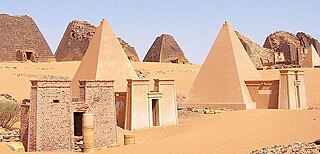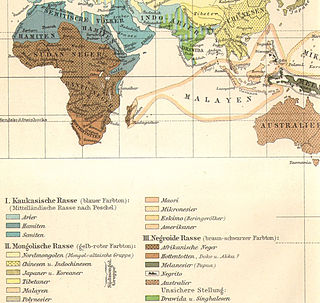
The Nile is a major north-flowing river in northeastern Africa. It flows into the Mediterranean Sea. The Nile is the longest river in Africa and has historically been considered the longest river in the world, though this has been contested by research suggesting that the Amazon River is slightly longer. Of the world's major rivers, the Nile is one of the smallest, as measured by annual flow in cubic metres of water. About 6,650 km (4,130 mi) long, its drainage basin covers eleven countries: the Democratic Republic of the Congo, Tanzania, Burundi, Rwanda, Uganda, Kenya, Ethiopia, Eritrea, South Sudan, Republic of the Sudan, and Egypt. In particular, the Nile is the primary water source of Egypt, Sudan and South Sudan. Additionally, the Nile is an important economic river, supporting agriculture and fishing.

North Africa, or Northern Africa, is a region encompassing the northern portion of the African continent. There is no singularly accepted scope for the region, and it is sometimes defined as stretching from the Atlantic shores of Mauritania in the west, to Egypt's Suez Canal in the east.

Afrocentrism is an approach to the study of world history that focuses on the history of people of recent African descent. It is in some respects a response to Eurocentric attitudes about African people and their historical contributions. It seeks to counter what it sees as mistakes and ideas perpetuated by the racist philosophical underpinnings of Western academic disciplines as they developed during and since Europe's Early Renaissance as justifying rationales for the enslavement of other peoples, in order to enable more accurate accounts of not only African but all people's contributions to world history. Afrocentricity deals primarily with self-determination and African agency and is a pan-African point of view for the study of culture, philosophy, and history.
Upper Egypt is the southern portion of Egypt and is composed of the Nile River valley south of the delta and the 30th parallel N. It thus consists of the entire Nile River valley from Cairo south to Lake Nasser.
Nubians are an ethnic group indigenous to the region which is now northern Sudan and southern Egypt. They originate from the early inhabitants of the central Nile valley, believed to be one of the earliest cradles of civilization. In the southern valley of Egypt, Nubians differ culturally and ethnically from other Egyptians, although they intermarried with members of other ethnic groups, especially Arabs. They speak Nubian languages as a mother tongue, part of the Northern Eastern Sudanic languages, and Arabic as a second language.

The prehistory of North Africa spans the period of earliest human presence in the region to gradual onset of historicity in the Maghreb (Berber:Tamazgha) during classical antiquity. Early anatomically modern humans are known to have been present at Jebel Irhoud, in what is now Morocco, approximately 300,000 years ago. The Nile Valley region, via ancient Egypt, contributed to the Neolithic, Bronze Age and Iron Age periods of the Old World, along with the ancient Near East.

Meroë was an ancient city on the east bank of the Nile about 6 km north-east of the Kabushiya station near Shendi, Sudan, approximately 200 km north-east of Khartoum. Near the site is a group of villages called Bagrawiyah. This city was the capital of the Kingdom of Kush for several centuries from around 590 BC, until its collapse in the sixth century AD. The Kushitic Kingdom of Meroë gave its name to the "Island of Meroë", which was the modern region of Butana, a region bounded by the Nile, the Atbarah and the Blue Nile.
Chancellor Williams was an American sociologist, historian and writer. He is noted for his work on African civilizations prior to encounters with Europeans; his major work is The Destruction of Black Civilization (1971/1974). Williams remains a key figure in the Afrocentrist discourse.

Yosef Alfredo Antonio Ben-Jochannan, referred to by his admirers as "Dr. Ben", was an American writer and historian. He was considered to be one of the more prominent Afrocentric scholars by some Black Nationalists, while most mainstream scholars, such as Mary Lefkowitz, dismissed him because of the basic historical inaccuracies in his work, as well as disputes about the authenticity of his educational degrees and academic credentials.
Northeast Africa, or Northeastern Africa or Northern East Africa as it was known in the past, is a geographic regional term used to refer to the countries of Africa situated in and around the Red Sea. The region is intermediate between North Africa and East Africa, and mainly encompasses the Horn of Africa and as well as Egypt. The region has a very long history of habitation with fossil finds from the early hominids to modern human and is one of the most genetically and linguistically diverse regions of the world, being the home to many civilizations and located on an important trade route that connects multiple continents.

Ancient Aethiopia, first appears as a geographical term in classical documents in reference to the upper Nile region of Sudan, as well as certain areas south of the Sahara. Its earliest mention is in the works of Homer: twice in the Iliad, and three times in the Odyssey. The Greek historian Herodotus "specifically" uses the appellation to refer to such parts of sub-Saharan Africa as were then known within the inhabitable world.

Black orientalism is an intellectual and cultural movement found primarily within African-American circles. While similar to the general movement of Orientalism in its negative outlook upon Western Asian – especially Arab – culture and religion, it differs in both its emphasis upon the role of the Arab slave trade and the Coolie slave trade in the historic relationship between Africa and the Arab – and greater Muslim – world, as well as a lack of colonial promotion over the Middle East region as was promoted by European orientalism in the same region. The term "black orientalism" was first used by Kenyan academic Ali Mazrui in his critique of Henry Louis Gates, Jr.'s documentary Wonders of the African World. Supporters of this movement include writers such as Chinweizu.

The question of the race of ancient Egyptians was raised historically as a product of the early racial concepts of the 18th and 19th centuries, and was linked to models of racial hierarchy primarily based on craniometry and anthropometry. A variety of views circulated about the racial identity of the Egyptians and the source of their culture. Some scholars argued that ancient Egyptian culture was influenced by other Afroasiatic-speaking populations in North Africa, the Horn of Africa or the Middle East, while others pointed to influences from various Nubian groups or populations in Europe. In more recent times some writers continued to challenge the mainstream view, some focusing on questioning the race of specific notable individuals such as the king represented in the Great Sphinx of Giza, native Egyptian pharaoh Tutankhamun, Egyptian Queen Tiye, and Greek Ptolemaic queen Cleopatra VII.

Hamites is the name formerly used for some Northern and Horn of Africa peoples in the context of a now-outdated model of dividing humanity into different races which was developed originally by Europeans in support of colonialism and slavery. The term was originally borrowed from the Book of Genesis, where it is used for the descendants of Ham, son of Noah.

Nubia is a region along the Nile river encompassing the area between the first cataract of the Nile and the confluence of the Blue and White Niles, or more strictly, Al Dabbah. It was the seat of one of the earliest civilizations of ancient Africa, the Kerma culture, which lasted from around 2500 BC until its conquest by the New Kingdom of Egypt under Pharaoh Thutmose I around 1500 BC, whose heirs ruled most of Nubia for the next 400 years. Nubia was home to several empires, most prominently the Kingdom of Kush, which conquered Egypt in the eighth century BC during the reign of Piye and ruled the country as its 25th Dynasty.

The Kingdom of Kush, also known as the Kushite Empire, was an ancient kingdom in Nubia, centered along the Nile Valley in what is now northern Sudan and southern Egypt.

Egypt has a long and involved demographic history. This is partly due to the territory's geographical location at the crossroads of several major cultural areas: North Africa, the Middle East, the Mediterranean and Sub-Saharan Africa. In addition, Egypt has experienced several invasions and being part of many regional empires during its long history, including by the Canaanites, the Ancient Libyans, the Assyrians, the Kushites, the Persians, the Greeks, the Romans, and the Arabs.

Human habitation in the North African region began over one million years ago. Remains of Homo erectus during the Middle Pleistocene period, has been found in North Africa. The Berbers, who generally antedate by many millennia the Phoenicians and the establishment of Carthage, are understood to have arisen out of social events shaped by the confluence of several earlier peoples, i.e., the Capsian culture, events which eventually constituted their ethnogenesis. Thereafter Berbers lived as an independent people in North Africa, including the Tunisian region.

The civilization of ancient Egypt was indebted to the Nile River and its dependable seasonal flooding. The river's predictability and fertile soil allowed the Egyptians to build an empire on the basis of great agricultural wealth. Egyptians are credited as being one of the first groups of people to practice agriculture on a large scale. This was possible because of the ingenuity of the Egyptians as they developed basin irrigation. Their farming practices allowed them to grow staple food crops, especially grains such as wheat and barley, and industrial crops, such as flax and papyrus.
Hoteps are a subculture of African Americans who use Ancient Egypt as a source of black pride. The community is Afrocentrist and it has also been described as promoting a false history. One of the group's more recognizable beliefs is the theory that the Ancient Egyptians were a racially homogeneous civilization which was uniformly made up of a single ethnic group of Black people, as opposed to the more accepted theory that the Ancient Egyptians were an extremely diverse society, consisting of people who were indigenous to the Egyptian Nile valley, ethnic groups that lived in the desert, Libyans, Sudanese, and eventually Greeks and Arabs after conquests.













